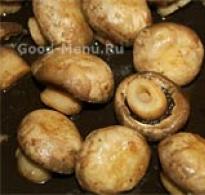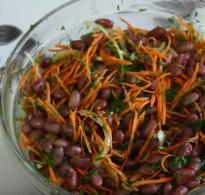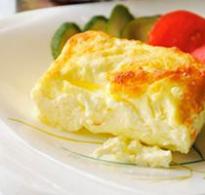What is made from pork snouts? What can you cook from pork snouts?
I would like to introduce you to such a delicacy as pork snouts. They taste very much like tongue meat. There is no fat on them. In cross section, even in structure, they are similar to a tongue. The patch is covered with skin, which is easily removed. What can you cook from pork snouts? You can make many delicious dishes from them. Piglets have gelling properties; you can use them to make excellent clear jellied meat or aspic without using gelatin in the recipe. And if you suddenly see pork snouts on sale, don’t pass them by!
To prepare jellied pork snouts you will need:
pork snouts - 2 kg;
onion - 1 pc.;
carrots - 1 pc.;
garlic - 8-12 cloves;
allspice - 6 pcs.;
salt - to taste.
The snouts are covered with thin skin. When preparing them for sale, the skin is removed, but due to carelessness, it remains in some places, so we remove it.
Fill the pork snouts with cold water, bring to a boil, drain the water, and fill with three liters of clean cold water. Bring to a boil. If you want the jellied meat to be transparent, do not let the jellied meat boil. Watch how it boils. It should be cooked on the lowest heat. The jellied meat does not boil, it simmers. Cook for approximately 5 hours.
Peel the onions and carrots, 1 hour before the end of cooking, add them to the jellied meat along with pepper and salt.
We peel the garlic, we have very small cloves, we used 12 pieces.
Remove the pork snouts from the finished broth and chop them.
I would like to show a cross-section of a pork snout.
Place the disassembled meat on plates. You can decorate with carrots or herbs, but our kids don’t like it.
Pour the broth. And one more little tip. To make the jellied meat tasty when you try it, add salt so that the broth is just a little too salty.
When the jellied meat in the plates has cooled, put it in the refrigerator. From this portion we got 5 plates of jellied meat.
The photo shows a piece of our jellied pork snouts; it is clean, transparent and tasty.
Bon appetit!
There are products that, even if you try very hard, are almost impossible to spoil. For example, pork.
Every housewife has her own secrets for preparing a hearty lunch or dinner from this meat: pork is baked, boiled, stewed, grilled. Pork is stuffed with vegetables and cooked with fruits.
You can safely experiment with this meat and come up with your own original recipes. Various seasonings, marinades and sauces allow you to do this. The easiest and fastest way is to marinate a piece of loin in soy sauce with seasonings without salt and bake in foil. Voila - and the table is set. Smoked brisket soups, grilled ribs, and neck chops will be loved by the whole family.
It’s worth going to a good butcher’s shop and your eyes will widen from the abundance: hams, ribs, loin, brisket, shoulder... And what ready-made masterpieces the butcher presents us with: sausages, bacon, boiled pork and ham, aromatic knuckle...
If you can’t decide on a piece, then just ask a professional to choose what you need for the intended dish.
And one more secret: when cooking pork yourself, be sure to ensure that the juice that is released is clear and that the meat is well fried or stewed: pork cannot be half-cooked!
Finnish baked neck
Pork neck 1.5–2 kg
2 red onions
1 cup berries (lingonberries, cranberries)
2 tbsp. spoons of honey
Olive oil
Salt, pepper
How to cook
Rinse a piece of pork and dry it with a paper towel. Cut into slices about 1.5 cm thick, leaving 2 cm short of the base of the piece.
Salt and pepper the meat.
Mash the berries, add honey and stuff the meat between the slices.
Cut the onion into rings and cover the pork with them.
Tie the meat with a strong thread and coat it with butter.
Place in a baking dish, cover with foil, bake for 1 hour at 200 degrees.
After 1 hour, remove the foil from the pan, reduce the temperature to 180 degrees and bake for another 30 minutes until a crust appears.
Serve by cutting into portions and pouring over the sauce.
Bon appetit!
Roll with herbs and cheese
1–1.5 kg pork tenderloin
1 red bell pepper
Bunch of basil, parsley, thyme
A handful of shelled pistachios
2 cloves garlic
1 sprig rosemary
150 g grated cheese
50 g sun-dried tomatoes (can be replaced with canned ones in oil, drain it first)
Olive oil
Salt, pepper
1 bottle of light beer
2 tbsp. spoons Dijon mustard
1 tbsp. spoon of honey
Peppercorns
How to cook
Cut the washed and dried piece of meat into a layer, cover with cling film and beat off.
Cut the pepper into small cubes; Chop sun-dried tomatoes, pistachios, garlic, basil, parsley and thyme.
Salt and pepper the layer of meat and sprinkle with cheese.
Place chopped vegetables, nuts and herbs on the cheese. Roll the meat into a roll and leave for 10 minutes. Tighten the roll with a stiff thread.
Prepare the sauce: mix beer, honey and mustard, add rosemary leaves and peppercorns.
Place the roll in the pan, pour over the sauce and bake at 200 degrees for 1.5–2 hours, periodically basting with the released juice and sauce.
Bon appetit!
Pork medallions with garlic sauce
700 g pork tenderloin, cut into medallions
Olive oil
Freshly ground black pepper
Head (whole) of garlic
250 ml milk
40 g butter
How to cook
Prepare the sauce: simmer the garlic in milk in a saucepan over low heat until the garlic softens (about 30 minutes, adding milk to replace the boiled milk). Season with salt and pepper, blend in a blender, and set aside.
Pour olive oil into a frying pan, heat it up high and fry the medallions on both sides until golden brown, place on heated plates.
In the same frying pan where you cooked the meat, heat the sauce by adding butter.
Serve the medallions with a generous amount of sauce.
Bon appetit!
Pork chops in balsamic vinegar
4 pork chops on the bone
3 tbsp. spoons Dijon mustard
120 ml dry white wine
1 clove of garlic
A few sprigs of sage
2 tbsp. spoons of olive oil
4 tbsp. tablespoons dark balsamic vinegar
Handful of flour
Pepper, salt
How to cook
Coat the prepared chops with mustard, sprinkle with flour, and set aside.
Chop the sage and garlic, fry for 1 minute in a mixture of olive oil and butter.
Add the chops to the pan and fry on both sides.
Pour in the wine, let the wine absorb and evaporate.
Before finishing cooking, pour vinegar over the meat.
Serve with vegetables, sprinkled with herbs.
Bon appetit!
Spaghetti with bacon
1 pack of spaghetti (400 g)
150 g smoked bacon
4 tomatoes
1 onion
4 tbsp. tablespoons grated parmesan
A pinch of ground cayenne pepper
Olive oil
Salt, freshly ground black pepper
How to cook
Cut the bacon into cubes, fry in olive oil, add chopped onion, and brown.
Boil spaghetti in salted water until half cooked.
Peel the tomatoes and remove seeds, cut them and add to the bacon, season.
Drain the pasta, mix with the sauce, sprinkle with Parmesan.
Bon appetit!
Onion soup
400 g pork ribs
50 g bacon
1 kg silver onion
2 cloves garlic
2 celery stalks
2 carrots
5 slices of wheat bread
Olive oil
Salt, pepper
How to cook
Coarsely chop the vegetables and 1 onion and boil along with the ribs.
Cut the rest of the onion into thin half rings.
Cut the bacon into cubes and fry in a pan in olive oil, gradually adding the onion.
Strain the meat broth, pour into a saucepan with bacon, cook for 1 hour.
Trim the meat from the ribs and add to the soup.
Toast the bread in a toaster, grate with garlic and serve with the soup.
Bon appetit!
Pork knuckle
Knuckle 1–1.5 kg
Coarse sea salt
4-5 bay leaves
Freshly ground black pepper
2 tbsp. spoons of honey
2 tbsp. spoons of mustard
2 tbsp. spoons of soy sauce
4 cloves garlic
1 bottle of beer
Olive oil
How to cook
Crush the garlic with salt, pepper, garlic and bay leaf.
Add honey to the garlic paste, 2 tbsp. spoons of olive oil, mustard and soy sauce.
Make incisions on the shank, fill them with marinade, distribute the remainder over the entire surface of the meat, leave for 30 minutes.
Place the meat in a deep baking tray, pour beer on the bottom and bake for 1.5 hours at 250 degrees, then reduce the heat to 180 degrees and leave for another 30 minutes.
Serve the shank with stewed cabbage and fried potatoes.
Bon appetit!
Terrine in bacon
200 g bacon strips
500 g minced pork
300 g chicken liver
100 g canned champignons
1 onion
4 cloves garlic
1 tbsp. skate spoon
1 tbsp. spoon of butter
Salt, pepper
How to cook
Finely chop the onion and garlic and fry.
Finely chop the liver and herbs, add the fried onion and garlic and mix with the minced meat, pepper and salt.
Add cognac and lightly beaten egg to the minced meat. Gently stir in the sliced mushrooms.
Grease a baking dish and line it crosswise with strips of bacon so that the edges hang over. Press the minced meat into the mold, cover with the ends of the bacon, avoiding gaps.
Fill a baking tray with water, place the pan with pate in it, cover the pan with foil. Bake at 190 degrees for 1.5 hours.
After cooking, drain off excess fat and place the dish in the refrigerator overnight.
Bon appetit!
Country style pie
300–400 g pork fillet (depending on the size of the mold)
150 g smoked brisket
1 pack of puff pastry dough
1 large onion
3 slices wheat bread
1 clove of garlic
1 small sweet pepper
A small bunch of Provençal herbs
Salt, pepper
1 tbsp. spoon of cognac
How to cook
Cut the meat and brisket into small cubes.
Chop the onion, herbs, pepper and garlic. Lightly beat the egg and crumble the bread.
Mix all ingredients, add cognac and egg, season with salt and pepper, put in the refrigerator for 20 minutes.
Divide the dough into two parts, roll out to the size of the mold, taking into account the sides.
Grease the mold with oil, place the first layer of dough, make sides. Using a fork, prick the dough in several places.
Lay out and smooth out the filling, cover with a second layer of dough, pinch the edges and brush the surface with egg. Cover loosely with foil.
Bake for 40 minutes at 200 degrees, then reduce to 180 degrees and bake for another 1 hour.
Bon appetit!
Filet in an omelet
1 long piece of pork tenderloin (about 500 g)
Marjoram, parsley, basil
50 ml medium fat cream
2 tbsp. spoons of wheat flour
Olive oil
Pinch of nutmeg
Salt, pepper
How to cook
Heat the oil in a wide frying pan and fry the whole piece of meat until golden brown, add salt and pepper.
Mix eggs, cream, chopped herbs in a bowl, season with nutmeg, salt and pepper.
Sift flour into the egg mixture and stir.
Fry the omelette in the same pan where you fried the meat.
Place the omelette on a serving plate and carefully wrap it around a piece of meat and cut into portions.
Serve with vegetables and herbs.
Bon appetit!
what can you cook from pork snouts?
- Boil a medium-sized pork snout in water with the addition of carrots, celery, onions, garlic, pepper and juniper berries; the tart aroma of the berries will add a noble note to the dish. Cook until done, which can be easily checked by piercing the meat with a toothpick.
Serve with a sauce that adds extra flavor and/or roasted vegetables flavored with thyme and rosemary.For the sauce, cook caramel from 1 tbsp. l. sugar, fry in it coarsely chopped and pre-boiled (you can do it with a nickel) 1 carrot and #189; celery root, 3 cloves of garlic, add 1 tbsp. l. tomato paste, pour in 0.5 liters of red wine and boil until thick. Then dilute the mass with a liter of demi-glace broth (highly concentrated) and again boil to the desired thickness. Add salt, pepper, a spoonful of honey and a sprig of rosemary, as well as 5-6 juniper berries (dried ones are sold in markets and specialized grocery stores).
P.S. An old Latvian belief says that the one who eats a pig's tongue will not have a word in his pocket, and those who like to eat pig's ears are guaranteed good hearing.
However, the most honorable role is assigned to the pig's snout. Our ancestors believed that it should be eaten by farmers to make plowing easier, and by children in order to quickly master the art of writing. The logic of the latter is beyond the understanding of modern man, but this does not make the patch any less tasty.
- Shish kebab at home
One of the most delicious recipes. We take pork (preferably the neck - it has the most tender meat and moderate fat or ribs). Cut into pieces the size of 2 matchboxes. We marinate (salt, black pepper, onion minced through a meat grinder, for those who like it - cilantro. Under no circumstances - vinegar!! We leave all this in a saucepan in the refrigerator (not in the freezer) for - for a day.
Heat up a large frying pan (the frying pan should be 2-3 times “more meat”, no less!).
Pour a little vegetable oil and add the meat. Fry the meat until half cooked, but not for long (marinated meat is enough - 15 minutes over high heat, stirring).
While the meat is fried, prepare the vegetables: several small red tomatoes, several halves of bell pepper, onions cut into halves, eggplants cut into large cubes, 2-3 pods of hot red pepper. We salt everything to taste, but do not pepper it.
Then place the pieces evenly in the pan and arrange the vegetables. Lightly crush the vegetables and add salt. When, after another 20 minutes, the vegetables are fried (all over high heat), you can press them again to release the juice and cover with a lid for 10 minutes. Just try not to crush the hot pepper, otherwise it will be very spicy later.
Serve directly in the pan with fluffy lavash. The greatest pleasure is soaking the liquid and softened delicious vegetables with pita bread.
No side dish required, but mashed or boiled potatoes can be served
Bon appetit! - Ingredients for "Casserole...piglets"
Potatoes (cooked in their jackets.)
Sausages (the more the better.)
Onion
Vegetable oil
Salt
Seasoning
Recipe "Casserole...piglets"
Peel the potatoes, boiled in their jackets, and grate them on a coarse grater.Cut the sausages into “pockets” and fry in vegetable oil.
Pork snouts are a rather unusual offal for us. Some people are disdainful of cooking and eating snouts, while others are simply unaware of their exquisite taste. In general, pork nickels are very rare on our table, but in vain. The finished snouts taste like tongue, which is recognized by everyone as a delicacy. Why are snouts worse? In addition, they have excellent gelling properties. Therefore, you can use them to prepare rich jellied meats and jellied dishes that are guaranteed to harden without adding gelatin.
Unlike other parts of the pork carcass, the snouts are low-fat and are perfect for a diet menu. This product is quite common in South American countries. For example, in Mexican restaurants, pork snouts are a signature (expensive) dish, which local virtuoso chefs proudly present to tourists.
If you are convinced of the edibility of this offal, then allow me to present you with one of the recipes for preparing snouts.
Mexican pork snouts fried in batter
This snack is quite popular in Mexico and is usually served with beer or local tequila.
For preparation you will need:
- pork snouts (fresh or frozen);
- corn flour;
- light beer;
- unsweetened soda;
- vegetable oil;
- a pinch of salt and pepper.
Cooking method:
If the snouts are frozen, defrost them and wash them thoroughly in warm water. Put water on the fire, add salt and boil the snouts until half cooked. After this, remove the offal from the broth and cool.
In a bowl we prepare beer batter, its quantity depends on the number of patches (for 1 serving you will need 2 patches). Pour in a few tablespoons of cornmeal and dilute it with equal proportions of light beer and unsweetened mineral carbonated water so that the batter resembles the consistency of pancake batter. Season the batter with salt and pepper to taste; you can add a mixture of spices to the meat or pork.
Lightly beat the cooled snouts with the flat part of a mallet, dip them in beer batter and fry until golden brown on both sides. Place the snouts only in hot vegetable oil so that the batter does not absorb excess fat. Place the finished snack on napkins to remove any remaining fat. This delicious appetizer of pork snouts is ready. You can serve it with a glass of beer, spicy ketchup or mustard sauce. Such snouts are good both hot and cold. Bon appetit!






